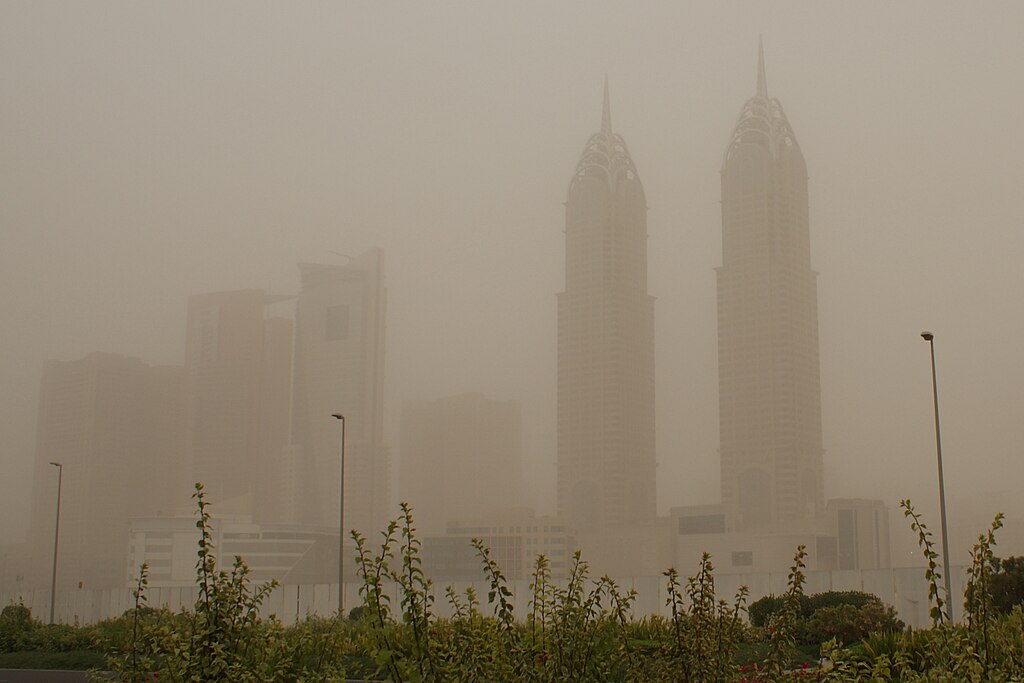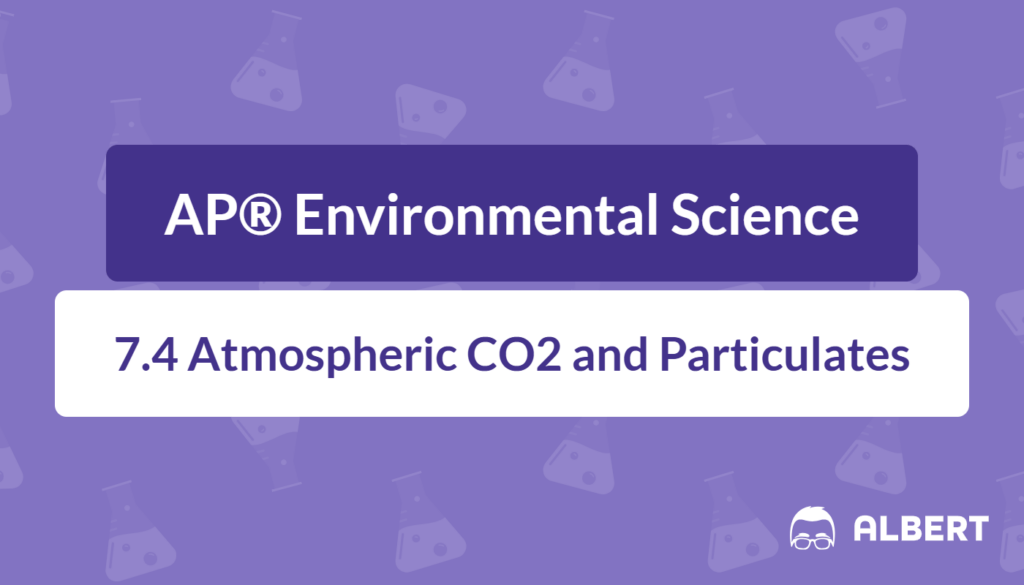What We Review
Introduction
Atmospheric carbon dioxide (CO2) and particulate matter play significant roles in environmental systems and climate processes. These components shape life on Earth in various ways, from plant growth to air quality. It is crucial to understand how CO2 and particulates enter the atmosphere, where they come from naturally, and how they affect global conditions. Therefore, this overview connects core ideas about CO2 and particulates to real-world examples, revealing the importance of studying natural processes such as respiration, decomposition, volcanic eruptions, and events that create particulates like wildfires, dust storms, and sea spray.
Moreover, recognizing these natural sources underscores the broader interactions within the carbon cycle and climate systems. By breaking down several foundational concepts and providing step-by-step examples, this review aims to clarify some of the central topics that appear on the AP® Environmental Science exam.
What Is CO2 and Why Is It Important?
Carbon dioxide (CO_2) is a colorless gas that arises naturally in Earth’s atmosphere. It consists of one carbon atom and two oxygen atoms linked together. However, despite its simple composition, CO2 has profound impacts on ecosystems and climate patterns. Plants depend on CO2 for photosynthesis, a process that uses solar energy to convert CO2 and water into glucose and oxygen. In symbolic form:
6 CO_2 + 6 H_2O \rightarrow C_6H_{12}O_6 + 6 O_2Additionally, animals (including humans) rely on the oxygen produced by plants to support respiration. Therefore, carbon dioxide occupies a central position in the carbon cycle, facilitating energy flow between living organisms and the atmosphere. This gas also functions as a greenhouse gas, regulating Earth’s temperature and helping to maintain conditions suitable for life.
Natural Sources of CO2
CO2 appears naturally in the atmosphere from several key sources. These include processes such as respiration, decomposition, and volcanic eruptions. Each process contributes to the carbon cycle and influences overall natural CO2 levels.
Respiration
All living organisms perform cellular respiration to release energy from food. Although plants take in CO2 for photosynthesis, they also respire and return some CO2 to the atmosphere. In humans, cells use oxygen to break down glucose, releasing CO2 and water as byproducts.
Step-by-step example of human respiration:
- Inhalation brings oxygen into the lungs.
- Oxygen moves from the lungs into the bloodstream.
- Cells absorb oxygen to help break down glucose molecules.
- Energy is released to fuel metabolic activities, producing water and CO2.
- Exhalation of CO2 (and water vapor) returns carbon to the atmosphere.
Thus, respiration ensures that carbon flows back into the atmosphere even as it cycles through different organisms.
Decomposition
When organisms die, decomposition breaks down their tissues into simpler substances, such as CO2 and nutrients. Decomposers, including bacteria and fungi, are essential for releasing carbon stored in dead organic matter back into the atmosphere. Therefore, decomposition continues the loop of carbon cycling throughout ecosystems.
Step-by-step example of decomposition in nature:
- An organism dies, leaving organic material.
- Bacteria and fungi colonize the material.
- Complex molecules (proteins, carbohydrates) are broken down into smaller compounds.
- Carbon from the organic matter is released as CO2.
- Nutrients become available for plants and other organisms.
Hence, decomposition not only replenishes soil nutrients but also contributes to atmospheric CO2 levels.
Volcanic Eruptions
Volcanoes are another source of natural CO2, albeit one that can be dramatic and sporadic. Magma underground contains dissolved gases, including CO2. When a volcano erupts, these gases escape into the atmosphere.
Step-by-step example of volcanic eruption impact on CO2:
- Magma rises toward Earth’s surface.
- Pressure decreases, causing dissolved gases to form bubbles.
- Volcanic eruptions release CO2, ash, and other substances into the air.
- Winds distribute CO2 and particulates over local and sometimes global ranges.
- Gradually, the CO2 mixes into the general atmosphere, adding to the planetary carbon cycle.
Although volcanic emissions represent a smaller fraction of total atmospheric CO2 compared to human-related sources, they remain a significant natural contributor.
Understanding Particulates in the Atmosphere
Particulate matter, often referred to as “particulates” or “aerosols,” consists of tiny solid or liquid particles suspended in the air. These particles can include dust, soot, pollen, and droplets of various chemicals. Particulates vary in size, but their effects on health and the environment can be considerable. Small particulates can enter respiratory systems and cause breathing problems, while larger particulates can scatter sunlight and influence local weather patterns.
Furthermore, particulates can affect temperatures by reflecting sunlight (leading to cooling) or absorbing heat (contributing to warming). Therefore, understanding both natural and human-made sources of particulate matter is essential to assess air quality and climate processes.
Natural Sources of Particulate Matter
Numerous events in nature contribute to the presence of particulates in the atmosphere. These events include wildfires, dust storms, and sea spray. Although human activities can amplify these occurrences, the processes themselves frequently arise from natural conditions.
Wildfires
Wildfires, whether sparked by lightning or other natural causes, generate large amounts of smoke. Smoke contains soot, ash, and other particulates that can travel hundreds or thousands of miles, depending on wind patterns.
Step-by-step example of wildfire particulate creation:
- An ignition source, such as a lightning strike, ignites dry vegetation.
- Flames consume biomass, producing soot and ash.
- Rising heat carries particulates into the atmosphere.
- Winds disperse these pollutants over wide areas.
- Eventually, a portion of the particulates settles onto surfaces, while some remain airborne.
Interestingly, wildfire particulates can have short-term cooling effects by reflecting sunlight back into space, but they can also reduce air quality in nearby communities.
Dust Storms
Dust storms arise when strong winds pick up loose soil, sand, and other fine particles from land surfaces. These particles become airborne, sometimes forming massive plumes.
Step-by-step example of dust storm formation:
- A region experiences drought or low rainfall, leaving soil loose and dry.
- Strong winds sweep across the land, dislodging dust and sand from the surface.
- Particulates rise into the air and create a distinct cloud.
- The dust cloud travels with the wind, reducing visibility and deteriorating air quality.
- Eventually, gravity and decreasing wind speeds allow the particles to settle.
Hence, recurrent dust storms can have substantial impacts on soil fertility, public health, and atmospheric clarity.

Sea Spray
Sea spray occurs when ocean waves break, sending tiny droplets of salt water and organic matter into the air. This process adds salts and other particles to the atmosphere.
Step-by-step example of sea spray generation:
- Waves form on the ocean surface, especially during storms or strong winds.
- Water crashes, creating bubbles and foam.
- Bubbles burst at the water’s surface, propelling droplets into the air.
- Droplets dry quickly, leaving salt crystals and other tiny residues suspended as particulates.
- Winds disperse these particulates, mixing them within the troposphere.
Marine aerosols can influence cloud formation and regional weather by providing surfaces for water vapor to condense, demonstrating another link between the ocean and the atmosphere.
Connecting CO2 and Particulates to Climate Change
In the context of climate change, CO2 levels in the atmosphere are a prime concern. These molecules trap heat, helping maintain Earth’s temperature through the greenhouse effect. However, rising levels can disrupt the balance, leading to global warming and shifts in weather patterns. Natural sources like volcanoes, respiration, and decomposition have always contributed to this cycle, but the system remains sensitive to additional greenhouse gases from human activities.
Particulates also interact with climate by either reflecting solar radiation (cooling) or absorbing it (warming). Dust, salts, and soot can alter cloud properties, affecting rainfall patterns and atmospheric dynamics. Therefore, studying both CO2 and particulates clarifies how Earth’s climate system responds to natural events and anthropogenic influences. Moreover, understanding these concepts is essential for evaluating the effectiveness of renewable energy and other mitigation strategies aimed at reducing greenhouse gas emissions and air pollution.
Conclusion
Carbon dioxide and particulates each have pivotal roles in shaping Earth’s environmental conditions. While CO2 is central to the carbon cycle—powering photosynthesis and driving respiration—particulate matter influences air quality, public health, and local to global climate systems. Natural processes such as volcanic eruptions, wildfires, dust storms, sea spray, respiration, and decomposition all contribute to the constant cycling of these elements.
Altogether, learning about these natural sources helps illuminate the delicate balance between atmospheric components and environmental health. Students preparing for the AP® Environmental Science exam are encouraged to further explore how different components of the carbon cycle and particulate pathways connect to human activities and global climatic shifts.
Key Vocabulary
- Carbon Cycle: The process by which carbon moves between the atmosphere, oceans, ecosystems, and living organisms.
- Respiration: The metabolic process in living organisms that converts glucose and oxygen into energy, CO2, and water.
- Decomposition: The breakdown of dead organisms and organic waste by decomposers, releasing nutrients and CO2.
- Particulate Matter: Tiny solid or liquid particles suspended in the atmosphere, which can affect climate and human health.
- Volcanic Eruption: The release of magma, gases (including CO2), and ash from a volcano, adding materials to the atmosphere.
Sharpen Your Skills for AP® Environmental Science
Are you preparing for the AP® Environmental Science test? We’ve got you covered! Try our review articles designed to help you confidently tackle real-world AP® Environmental Science problems. You’ll find everything you need to succeed, from quick tips to detailed strategies. Start exploring now!
- AP® Environmental Science: 7.1 Review
- AP® Environmental Science: 7.2 Review
- AP® Environmental Science: 7.3 Review
Need help preparing for your AP® Environmental Science exam?
Albert has hundreds of AP® Environmental Science practice questions, free response, and full-length practice tests to try out.








